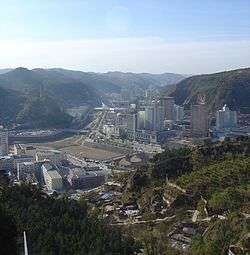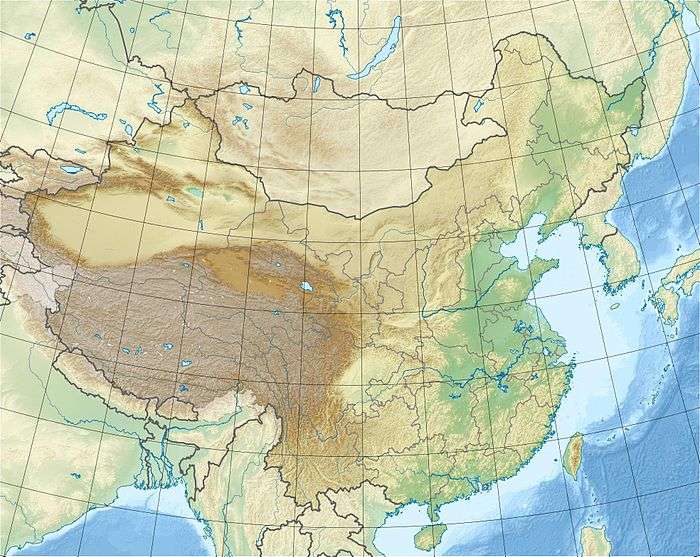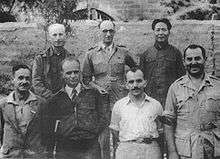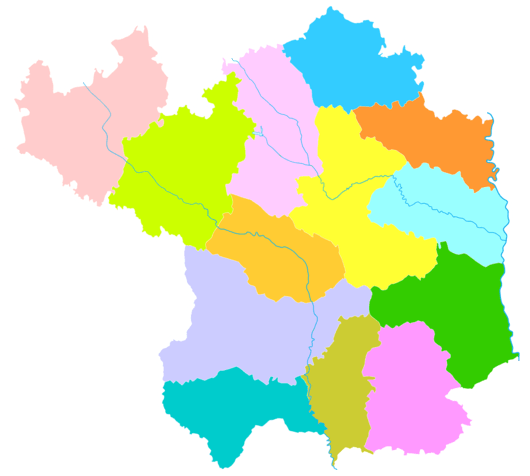Yan'an
Yan'an (Chinese: 延安; Mandarin pronunciation: [jɛ̌n.án]) is a prefecture-level city in the Shanbei region of Shaanxi province, China, bordering Shanxi to the east and Gansu to the west. It administers several counties, including Zhidan (formerly Bao'an), which served as the headquarters of the Chinese Communists before the city of Yan'an proper took that role.
Yan'an 延安市 Yenan | |
|---|---|
 | |
.png) Location of Yan'an City jurisdiction in Shaanxi | |
 Yan'an Location in China | |
| Coordinates (Yan'an municipal government): 36°39′00″N 109°29′38″E | |
| Country | People's Republic of China |
| Province | Shaanxi |
| Area | |
| • Total | 37,031.3 km2 (14,297.9 sq mi) |
| Elevation | 975 m (3,199 ft) |
| Population (2012) | |
| • Total | 2,198,100 |
| • Density | 59/km2 (150/sq mi) |
| Time zone | UTC+8 (China Standard) |
| ISO 3166 code | CN-SN-06 |
| License plates | 陕J |
| Website | www |
| Yan'an | |||||||||||||||||||||||
|---|---|---|---|---|---|---|---|---|---|---|---|---|---|---|---|---|---|---|---|---|---|---|---|
"Yán'ān" in Chinese characters | |||||||||||||||||||||||
| Chinese | 延安 | ||||||||||||||||||||||
| Hanyu Pinyin | Yán'ān | ||||||||||||||||||||||
| Postal | Yenan | ||||||||||||||||||||||
| |||||||||||||||||||||||
Yan'an was near the endpoint of the Long March, and became the center of the Chinese Communist revolution from late 1935 to early 1947. Chinese communists celebrate Yan'an as the birthplace of the revolution.
Administrative divisions
| Map | |||||
|---|---|---|---|---|---|
| Name | Hanzi | Hanyu Pinyin | Population (2012)[1] | Area (km²)[1] | Density (/km²) |
| Baota District | 宝塔区 | Bǎotǎ Qū | 476,900 | 3,537.6 | 134.81 |
| Ansai District | 安塞区 | Ānsài Qū | 172,900 | 2,951.3 | 58.58 |
| Zichang City | 子长市 | Zǐcháng Shì | 218,000 | 2,393.4 | 91.08 |
| Yanchang County | 延长县 | Yáncháng Xiàn | 126,000 | 2,361.6 | 53.35 |
| Yanchuan County | 延川县 | Yánchuān Xiàn | 169,300 | 1,986.5 | 85.23 |
| Zhidan County | 志丹县 | Zhìdān Xiàn | 141,600 | 3,790.2 | 37.36 |
| Wuqi County | 吴起县 | Wúqǐ Xiàn | 145,600 | 3,788.5 | 38.43 |
| Ganquan County | 甘泉县 | Gānquán Xiàn | 77,800 | 2,276.1 | 34.18 |
| Fu County | 富县 | Fù Xiàn | 150,500 | 4,179.9 | 36.01 |
| Luochuan County | 洛川县 | Luòchuān Xiàn | 221,900 | 1,791.3 | 123.88 |
| Yichuan County | 宜川县 | Yíchuān Xiàn | 117,900 | 2,937.2 | 40.14 |
| Huanglong County | 黄龙县 | Huánglóng Xiàn | 49,500 | 2,751.0 | 17.99 |
| Huangling County | 黄陵县 | Huánglíng Xiàn | 130,100 | 2,286.7 | 56.89 |
History
.jpg)
Yan'an was populated at least as early as the Sui dynasty. The Sui established a military base in Yan'an. The area became an important defensive outpost for the subsequent Tang dynasty.[2] In medieval China, Yan'an was called Yanzhou from the Western Wei dynasty to 1089, when it was renamed Yan'an. Yanzhou was a location of strategic military importance for the Chinese empire and Tanguts of the Western Xia Dynasty. It was once successfully defended by the Song Dynasty (960–1279) era Chinese scientist, statesman, and general Shen Kuo (1031–1095 AD). However, it was eventually taken over by the Tanguts in 1082 once Shen's defensive victories were marginalized and sacrificed by the new Chancellor Cai Que (who handed the city over to the Tanguts as terms of a peace treaty). Yan'an and the whole of Shaanxi were taken over by the Mongols in the late 1220s, only after their leader Genghis Khan had died during the siege of the Western Xia capital in 1227. The city was maintained by the successive Chinese Ming Dynasty (1368–1644), as well as the Manchu Qing Dynasty (1644–1911). After the fall of the Qing Dynasty, the city became part of the newly created Republic of China.
Red Capital

In December 1936, at the start of the Second United Front, Yan'an was taken over by the Chinese Communists.[3] They had arrived in the area in October 1935 after making the famous Long March from Jiangxi. When Edgar Snow went there in 1936, it was under Kuomintang control and a Red army siege had recently been lifted.[4] Unknown to him at the time, there had also been contacts there between the Communists and the generals who later staged the Xi'an Incident. Snow actually met Mao at Bao'an (Pao An).
Having rebelled against Chiang, the local warlords decided to hand over Yan'an to the Communists, who were now allies. They pulled out and the Red Army walked in without a fight. This is described by Agnes Smedley in her book Battle Hymn of China. She was in Xi'an at the time and got to Yan'an shortly after the take-over.
From 1937, Yan'an became the seat of the communist government of what became known as the Shaanxi-Gansu-Ningxia Border Region. It became the center for intensive training of party members and army troops. In 1941, Mao Zedong put special influence on a series of training programs to "correct unorthodox tendencies" and essentially mold the peasantry to the communist model. One of the first CPC programs launched was the Yan'an Rectification Movement.
World War II
During the Second World War almost all buildings, except a pagoda, were destroyed by Japanese bombing, and most inhabitants took to living in yaodongs, artificial caves or dugouts carved into hillsides which were traditional dwellings in Shaanxi. While Yan'an was the center of Chinese communist life many prominent Western journalists including Edgar Snow and Anna Louise Strong met with Mao Zedong and other important leaders for interviews. Hsiao Li and Michael Lindsay were part of the resistance movement.[5]
During the Second World War, Yan'an played host to the United States Army Observation Group, also known as the Dixie Mission. In addition to establishing relations, the goal was to investigate the Communist Party politically and militarily, and determine if the U.S. would benefit from establishing liaison. John S. Service, of the United States Department of State, was responsible for political analysis, and Colonel David D. Barrett of the United States Army performed the military analysis. The mission explored possible plans for cooperation against the Japanese. The Americans had a presence in Yan'an from 1944 to 1947.
Later history
Yan'an was briefly captured in the Battle of Yan'an by the Kuomintang forces in the Chinese Civil War. The Communist leadership learned of a planned attack in advance and decided to pull out. From then until their capture of Beijing they were usually based somewhere else, often with a mobile headquarters.
Geography and climate
Yan'an is located in northern Shaanxi on the south-central part of the Loess Plateau, with latitude spanning 35°21′–37°31′ N and longitude 107°41′–110°31′ E. It borders Yulin to the north, Xianyang, Tongchuan, and Weinan of the Guanzhong to the south, Linfen and Lüliang (Shanxi) to the east, and Qingyang (Gansu) to the west. Elevations generally increase from southeast to northwest, and the average elevation is over 1,000 m (3,280 ft).
Yan'an has a humid continental climate (Köppen climate classification Dwa) that borders on a steppe climate (Köppen BSk), with cold, dry, and moderately long winters, and hot, somewhat humid summers. Spring and autumn are short transition seasons in between. The monthly 24-hour average temperature ranges from −5.5 °C (22.1 °F) in January to 23.1 °C (73.6 °F) in July, and the annual mean is 9.90 °C (49.8 °F). The area receives 511 millimeters (20.1 in) of precipitation. With monthly percent possible sunshine ranging from 49% in September to 64% in January, the city receives 2,449 hours of sunshine per year.
| Climate data for Yan'an (1971–2000) | |||||||||||||
|---|---|---|---|---|---|---|---|---|---|---|---|---|---|
| Month | Jan | Feb | Mar | Apr | May | Jun | Jul | Aug | Sep | Oct | Nov | Dec | Year |
| Average high °C (°F) | 2.2 (36.0) |
5.6 (42.1) |
11.9 (53.4) |
20.2 (68.4) |
25.3 (77.5) |
28.7 (83.7) |
29.7 (85.5) |
28.2 (82.8) |
23.3 (73.9) |
17.6 (63.7) |
10.3 (50.5) |
3.9 (39.0) |
17.2 (63.0) |
| Average low °C (°F) | −11.0 (12.2) |
−7.2 (19.0) |
−1.0 (30.2) |
5.4 (41.7) |
10.6 (51.1) |
14.9 (58.8) |
17.8 (64.0) |
16.7 (62.1) |
11.4 (52.5) |
4.8 (40.6) |
−2.2 (28.0) |
−8.6 (16.5) |
4.3 (39.7) |
| Average precipitation mm (inches) | 3.0 (0.12) |
5.0 (0.20) |
17.6 (0.69) |
26.3 (1.04) |
41.7 (1.64) |
67.7 (2.67) |
112.1 (4.41) |
117.5 (4.63) |
68.0 (2.68) |
35.0 (1.38) |
13.6 (0.54) |
3.2 (0.13) |
510.7 (20.13) |
| Average precipitation days (≥ 0.1 mm) | 2.2 | 3.2 | 5.2 | 6.2 | 7.5 | 9.0 | 13.3 | 11.8 | 10.2 | 7.1 | 3.8 | 2.1 | 81.6 |
| Average relative humidity (%) | 53 | 52 | 54 | 48 | 51 | 59 | 70 | 74 | 74 | 69 | 63 | 57 | 60 |
| Mean monthly sunshine hours | 194.3 | 172.7 | 194.3 | 220.7 | 247.1 | 239.5 | 222.1 | 212.9 | 183.4 | 190.4 | 185.2 | 185.9 | 2,448.5 |
| Percent possible sunshine | 64 | 57 | 53 | 56 | 57 | 55 | 50 | 51 | 49 | 55 | 60 | 62 | 55 |
| Source: China Meteorological Administration | |||||||||||||
Economy
In 2018, the city's statistics bureau reported the city's GDP stood at 155.891 billion yuan, a 9.1% increase from the previous year.[6] The city's GDP per capita was reported 68,940 yuan, an increase of 8.9% from the previous year.[6] The following table shows the composition of the city's economy:[6]
| Sector | 2018 Value (yuan) | Percent of Total GDP | Growth from 2017 |
|---|---|---|---|
| Primary Industry | 13.807 billion | 8.857% | +2.9% |
| Secondary Industry | 92.597 billion | 59.399% | +9.8% |
| Tertiary Industry | 49.488 billion | 31.745% | +9.8% |
| Total GDP | 155.891 billion | 100.000% | +9.1% |
Agriculture
As of 2018, the city's agricultural output was worth 24.112 billion yuan, a 2.9% increase from the previous year at constant prices.[6] Of this, planting accounted for 20.139 billion yuan, animal husbandry accounted for 2.631 billion yuan, fishing accounted for 69 million yuan, and agricultural services accounted for 0.593 billion yuan.[6]
Industry
As of 2018, the city's industrial output was worth 87.074 billion yuan, a 10.4% increase from the previous year at constant prices.[6] Of this, the petroleum industry alone accounted for 54.419 billion yuan of output.[6] In addition to oil and natural gas, major industries in the city include coal mining, power generation, and cigarette production.[6]
Petroleum Industry
In 2018, 15,292,400 tons of crude oil were extracted from the city.[6] Of this, 8,565,800 tons were extracted by Yanchang Petroleum, and the remaining 6,726,600 tons were extracted as part of CNPC's Changqing Oil Field.[6] The Changqing Oil Field, part of the wider Ordos basin, one of China's main petroleum-producing regions, has been home to oil extraction since the early 1970's.[7]
Transportation
- Yan'an Nanniwan Airport
- G2211 Changyan Expressway
- G65 Baotou–Maoming Expressway
- China National Highway 210
Education
The city is home to 251 standard primary schools and 112 standard secondary schools, enrolling 218,100 and 129,900 students, respectively.[8] The city also has 556 kindergartens, enrolling 119,500 students. The city also has 5 special education schools, serving 372 disabled students.[8]
Notable Educational Institutions
- Yan'an University
- China Yan'an Executive Leadership Academy
See also
- Yan'an Rectification Movement
- Yan'an Talks on Literature and Art
- 2693 Yan'an
References
- 延安市-行政区划网(区划地名网) www.xzqh.org. XZQH.org. Retrieved April 19, 2020.
- Schellinger, Paul; Salkin, Robert, eds. (1996). International Dictionary of Historic Places, Volume 5: Asia and Oceania. London and Chicago: Fitzroy Dearborn Publishers. p. 874. ISBN 1-884964-04-4.
- Mao Tse Tung Ruler of Red China by Robert Payne, page 175
- Red Star Over China, by Edgar Snow. Page 42
- "Lady Lindsay of Birker". The Guardian. 1 June 2010. Retrieved 21 October 2012.
- 延安市2018年国民经济和社会发展统计公报_中国统计信息网. www.cnstats.org. Retrieved 2020-04-18.
- "Changqing Oil & Gas Province". CNPC. Retrieved April 18, 2020.
- 延安市2018年国民经济和社会发展统计公报_中国统计信息网. www.cnstats.org. Retrieved 2020-04-19.
External links
| Wikimedia Commons has media related to Yan'an. |

